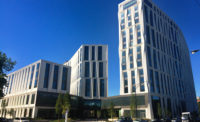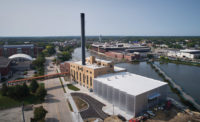The University of Chicago, long identified with its venerable Collegiate Gothic campus, has historically cordial relations with Hyde Park, the affluent enclave that surrounds it. But that rapport reached an urban design low in 1960, when Pierce Tower, Harry Weese’s 10-story red brick box adorned with bay windows and a mansard roof, and hovering on pilotis, was erected. The dormitory occupied the corner of 55th Street, a major east–west boulevard, and University Avenue, a leafy side street. Often maligned as a “fortress,” it blocked access and views, and a loading dock dominated its street presence.
Additional Information:Jump to credits & specifications
The need for more and better-quality housing and the desire for a more hospitable connection between town and gown led the university to replace Pierce, which had fallen into serious disrepair, with Studio Gang’s North Residential Commons, a recently completed 400,000-square-foot set of residence halls. The $148 million complex provides housing and dining facilities for 800 students—compared to 320 at Pierce—in a design that architect Jeanne Gang describes as “four slender bar buildings in an urban fabric of plazas, gardens, walkways, and courtyards.” Together, she says, they “form inviting public and semi-private outdoor spaces for students and neighbors.”
The four bars vary in height. The lowest, at two stories, is a green-roofed, steel-framed, glass-enclosed dining pavilion, positioned to create a diagonal pathway that leads from a plaza at the street corner to a new quadrangle. The heights of the other bars, which contain dormitories and are framed primarily in concrete and clad in sculpted precast panels, range from five to 15 stories. The lowest responds to the residential scale of University Avenue. The tallest follows the campus custom of not exceeding the 200-foot height of Bertram Goodhue’s 1928 Rockefeller Memorial Chapel and completes the urban edge of busy 55th Street, where shops and a restaurant will activate its ground floor. A single secure entry serves all three dorms, which are connected at the second level by a glass bridge.
The bars are slightly inflected at their centers to embrace curvilinear and organic outdoor spaces between them. These include two landscaped courtyards at the second level, accessible only to students, and the ground-level quad, which is open to all and arranged around a circular rain garden.
The two tallest bars define the quad’s northern and eastern boundaries, while two limestone-clad landmarks—the Gothic Henry Crown Field House (Holabird and Root, 1931) and the modernist Cochrane-Woods Art Center (Edward Larrabee Barnes, 1974)—delineate the other edges. At Gang’s suggestion, the university enhanced the quad’s western border by closing Greenwood Avenue, which ran directly in front of the Art Center.
The university’s “house” system, where 80 to 100 live together, gave the architects a module for distributing and articulating the program. Gang’s new dorms contain a total of eight houses organized around three-story-high communal spaces with distinct areas for studying, watching movies, cooking, and socializing. These hubs are located at the center of each bar, but, for the sake of variety in section and elevation, each is offset slightly.
The second tradition informing the design is the university’s architectural heritage. “The distinguishing characteristics of the Collegiate Gothic style,” explains design principal Todd Zima, “are verticality, rhythm, deep-set windows, limestone, and an organic plasticity that creates a strong play of light and shadow.”
This analysis inspired the Commons’ signature move: three-story-tall window bays—articulating the house module—surrounded by the boldly scaled sculptural frames of the precast-concrete panels, whose sinuously curved and diagonally warped shapes ripple out from the offset hubs in a subtly syncopated rhythm. The concrete’s color and texture, which results from acid washing and sandblasting, resembles limestone but costs much less. And its thermal resistance, augmented by fritted glass and metal grilles to create a 60–40 ratio of solid to glass, in what Zima describes as a “tuned facade,” works with a radiant heating and cooling system to meet the university’s energy-conservation goals.
Budget constraints kept interior finishes basic in the houses, but punchy colors (each house has its own) and clever details—such as seating platforms and bookshelves integrated with graceful steel stairs—animate the hubs. Major common areas are more luxe. The double-height dining hall—with polished white concrete floors, open stainless-steel kitchens, clerestory windows, and views to the quad through glass walls shaded by the decorative metal grilles—is luminous and elegant. The 15th-floor reading room is sheathed in oak, both for the floor and in wall and ceiling panels that riff on the facade geometry while framing panoramic vistas of the campus, the city, and Lake Michigan.
Creating welcoming links between a university and an adjacent neighborhood is always difficult. But when the site is a prominent corner bound by two streets of differing character at the edge of an historic campus, the challenge is even greater. Studio Gang rose to the occasion with a creative approach to context and a sure hand with forms and surfaces. The result is a stunningly beautiful residential complex, whose scale and siting are sensitive to its neighbors and whose underlying intelligence is well suited to a leading university.
PeopleArchitect: Studio Gang
Personnel in architect's firm who should receive special credit: Jeanne Gang, Mark Schendel, Todd Zima
Architect of record: Studio Gang
Associate architect: Hanbury
Engineers: dbHMS – MEP/Fire Protection Engineer Magnussen Klemencic Associates – Structural Engineer David Mason & Associates – Civil Engineer
Consultants Hood Design Studio – Landscape Concept Designer
General contractor: Mortenson Construction
Photographer: Steve Hall, Copyright Hedrich Blessing (312) 491-1101 / Copyright Tom Harris Photography 715.220.1282
|
ProductsStructural System Concrete and Steel Frame Manufacturer of any structural components unique to this project: K&K Iron Works (Steel Fabricator) Exterior Cladding Metal panels: RLS 9000 Wall Panel System - by All-American EXT Solution Metal/glass curtain wall: Schuco UCC 65 by Contract Glazier Inc Precast concrete: International Concrete Products (ICP) Moisture barrier: Horizontal: Stego Wrap Vapor Barrier Roofing Built-up roofing: Sikaplan adhered energy smart roof membrane system by Sika Other: Intensive Green Roof by Barrett RT250 System Glazing Glass: Interior storefront system: Kawneer VG450 Front Set Other: Custom Exterior Grilles by Contract Glaziers Inc Doors Entrances: 500 Standard Entrances by Kawneer Metal doors: Steelcraft B Series Wood doors: Architectural wood doors by VT Industries Hardware Locksets: Corbin Russwin - ML2000 Closers: 4040xD by LCN Exit devices: Von Duprin 98/99 Series Pulls: Ives Architectural Hardware Security devices: Exit Alarm: EAX 500 Series by Detex Interior Finishes Acoustical ceilings: TOPRERFO micro panel by TOPAKUSTIK Suspension grid: USG-Mars Climaplus Cabinetwork and custom woodwork: Amberleaf Kitchen Cabinets Paints and stains: Benjamin Moore Wall coverings: Filzfelt - 5mm wool design felt Plastic laminate: Wilsonart - Design White Solid surfacing: Corian - Glacier White Special surfacing: 1/4" natural cork on 1/4" substrate Floor and wall tile: Crossville: Carpet: Tandus centiva - grid overlay II Lighting Interior ambient lighting: Focal Point - Covert Perless wandwall Tasklighting: lithonia - rayzer Dimming system or other lighting controls: louis poulson - albertslund mini post Conveyance Elevators/escalators: Thysselkrupp Accessibility provisions: Universal Design Plumbing Elkay EZh20 Energy Energy management or building automation system: Johnson Controls Other unique products that contribute to sustainability: |
















Post a comment to this article
Report Abusive Comment